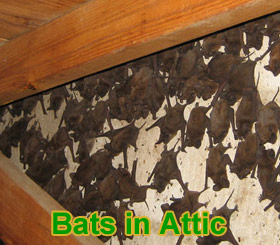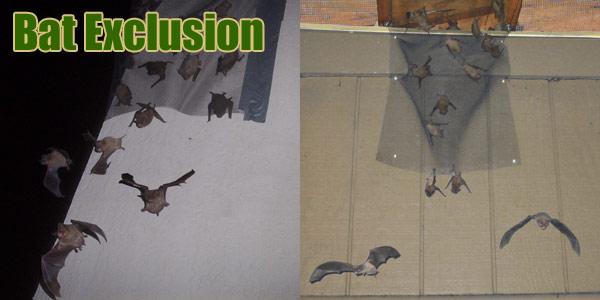- info@wildlife-removal.com
Call us for help in your town
Wildlife Removal Education
Bat Exclusion
Need bat removal in your hometown? We service over 500 USA locations! Click here to hire us in your town and check prices - updated for year 2020.
Click here for my nationwide list of 100's of bat removal experts serving every US town/city.
 I wrote this bat article for a pest control magazine, regarding the removal of bats from buildings and roofs. I am a bat removal expert with over 10 years and several hundred bat removal jobs under my belt. I have personally found that
I get the best results when I do the bat control work at night. I use a variety of bat exclusion devices, from netting to funnels, but the type of device doesn't matter, so long as it's installed correctly.
I do not advocate the general public to do bat removal work. It's honestly far too complicated, and a lot can go wrong if you don't have a lot of experience. I personally
trained for two years with an expert before I attempted any of my own bat control jobs solo, and even then, I still had a lot to learn! To get the job done right, hire a professional. Everything You Need to Know (and Buy) for Bat Exclusion
I wrote this bat article for a pest control magazine, regarding the removal of bats from buildings and roofs. I am a bat removal expert with over 10 years and several hundred bat removal jobs under my belt. I have personally found that
I get the best results when I do the bat control work at night. I use a variety of bat exclusion devices, from netting to funnels, but the type of device doesn't matter, so long as it's installed correctly.
I do not advocate the general public to do bat removal work. It's honestly far too complicated, and a lot can go wrong if you don't have a lot of experience. I personally
trained for two years with an expert before I attempted any of my own bat control jobs solo, and even then, I still had a lot to learn! To get the job done right, hire a professional. Everything You Need to Know (and Buy) for Bat Exclusion
Bat Exclusions - Don't be Afraid to Work in the Dark!
Wildlife control is a unique profession - anyone who does this job knows that! Part of the responsibility of a professional wildlife control operator is the willingness to work odd hours. Wild animals don't keep a Monday - Friday 9-5 schedule, and neither should you. What if a snake enters a house at midnight? What if a raccoon is caught in a trap on a Sunday? These issues must be addressed, both for the sake of the customer, and the welfare of the animal. When you sign on to this job, you accept the fact that you're not working normal hours.
With that in mind, I have some advice regarding bat exclusions. I highly recommend working at night. Bats are nocturnal creatures. They emerge from their daytime roost at night, they return to the roost several times each night, and they retire from their nightly foraging just before dawn. I have found through many years and several hundred bat exclusion jobs that the jobs go much better if done after sunset, for several reasons.
First of all, we all know that bats can fit through very small gaps: as small as 3/8 of an inch. - Bat entry holes: What they look like and how to find them - It's often very difficult, during a daytime inspection, to identify all of the potential bat entry/exit gaps, especially on certain types of architecture. If you do a night watch, you'll often be very surprised by some of the areas from which you see bats emerging. In fact, some bats will change their entry/exit holes as the season progresses. If you inspect during the daytime, you'll identify some areas as bat holes, by the brown staining, droppings, and odor, but it's possible that the bats aren't currently using that hole at all. They may have moved to a different section of the building. And if you don't get the exit hole right, you've got a big problem on your hands when you set up your excluders. What materials keep out bats? Only a night watch can truly verify how the bats are behaving.

Second of all, visibility of the structure is better at night. I know this is an absolute fact. During the daytime, vision is obscured by shadows and bright light in your eyes. It's often hard to get a real good look at the small gaps bats can utilize. But at night, with a headlamp pointing directly at the building, you see all kinds of architectural features in much greater detail than during the day. You just have to try this out for yourself, and you'll see right away - it's a huge advantage. What areas can bats enter a house through?
Third of all, bats are often apprehensive about exiting via your exclusion device. Whether you use netting, cones, or any other one-way exclusion material or device, the bats are going to see that something is awry, and balk at leaving. Sure, if you set it right, they will eventually leave, but I've seen problems. Sometimes they are stubborn. Sometimes your exclusion device didn't work as planned. If you do the job at night, you'll see any problems that occur, and you can properly address them. Heck, it might be something as simple as a bat getting a wing stuck in the netting, and blocking the other bats. If you're on the job at night, you can address such problems.
It's also easier on the bats. The majority fly out of the building at dusk. Yes, in most cases, some remain behind, and some bats return to the roost fairly quickly after exiting, drinking some water, and grabbing some insect dinner. But I like to isolate their primary exit hole(s), let them fly out of the building naturally, and then, after most are out, I install the exclusion device for the few remaining bats inside. I leave it up for at least two nights, just to be safe. It may seem unnecessary to do it this way, but I believe that it ensures a clean exit of most of the bats, rather than forcing them through the exclusion device.
In addition, much bat work is done in the summer months, and it's a lot cooler working at night! Coming from Florida, I really appreciate that.
Of course, ladder safety is always an issue, so I take extra care at night. I have found that with proper precaution and headlamp lighting, it's no more difficult to work at night than during the day.
I don't only do bat jobs at night. I have set up bat exclusions during the daytime. It can be done. But I have been on so many nighttime bat jobs in which I said to myself, "Holy Moley, it's a good thing I did this at night... I had no idea that hole was there, or those bats were leaving at that spot..." etc. Ultimately, wildlife control, including bat control, is an unpredictable field with many variables. You may think you know it all when it comes to bat control, but then you'll find yourself surprised again and again; by bat behavior, and the variables that come with different building architectures. Bats are active at night. If you do the work at night, you learn a great deal more about how the bats actually behave than if you try to do daytime bat work. I strongly recommend trying it at least once - you may find yourself, like I did, doing most of your bat exclusions after the sun has gone down.
I have written several other detailed articles:
How to get bats out of the attic
How to get bats out of the chimney
Bat exclusion tips and techniques
Bat trapping
How to inspect your house for bat entry
Bat prevention methods
Do bats chew on wires?
What does an evening bat look like?
The truth about bats and homeowners insurance
The Five Ways of Getting Bats Out of a Wall
Can bats chew though spray foam, wood, or screen?
Best Ways to Remove Bats from a Barrel Tile Roof
About Bat Bug Infestation
A Bat's Calendar
Noises Bats Make When They Are Living In Your House
How to Remove Animals from Barrel Tile Roofs
The author, David, is a bat removal expert with
over 500 successful bat control jobs under his
belt. I want to stress the importance of proper
bat removal, and the value of these animals to
the ecosystem. I've witnessed dozens of failed
do-it-yourself bat jobs over the years, and it
is not pretty - dead bats, horrible odors,
rabies vaccinations, and so on. What do I need to do after removing bats from my house? Bat removal work
is not easy - I trained for two years learning,
and even then, it took many jobs and hands-on
training before I was competent. I highly
recommend that you consult my list of wildlife
control companies on the home page, and hire a
professional to come out and look at your bat
problem. Get a few quotes if you must. Read more about Choosing the right company to get rid of bats. And
remember, do not perform any bat exclusions during the summer maternity months. When Should You Use One-Way Exclusion Devices to Get Rid of Bats? For more general information and links, go to my main bat removal page.


















